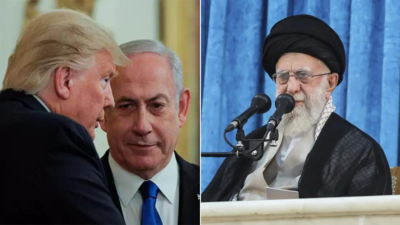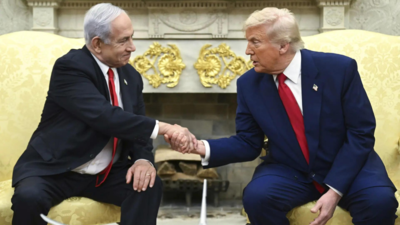Bombs, bluffs, and blame game: How US took centrestage in Iran-Israel conflict; ’12-day war’ recap

US President Donald Trump on Monday declared a “complete and total ceasefire” between Israel and Iran, signaling what he called the likely end of the 12-day conflict that drew in the United States and rattled the region. The announcement followed intense escalations, including US airstrikes on Iranian nuclear facilities and Iran’s retaliatory missile launch at an American base in Qatar. Trump’s declaration came even as hostilities persisted on the ground, with both sides continuing to exchange fire beyond the ceasefire deadline.While both Israel and Iran formally agreed to the ceasefire proposed by Washington, the situation remained unstable. Iran launched a final wave of missile strikes early Tuesday, killing at least four people in Israel. Israel also carried out pre-dawn airstrikes across Iranian territory. The Israeli military later accused Iran of violating the truce, prompting Prime Minister Benjamin Netanyahu to authorise further action. Iran denied the allegation, but missile sirens and explosions were reported in parts of northern Israel throughout the day. As Trump’s ceasefire declaration has yet to fully translate into calm on the ground, here’s a look at the conflict which began with a surprise Israeli strike on Iran’s nuclear and military infrastructure, quickly spiralled into a regional confrontation involving missile barrages, drone attacks, and the eventual entry of the United States with direct airstrikes on Iranian nuclear sites.
Over the course of nearly two weeks, key military and scientific figures were killed, major cities came under fire, and nuclear facilities were targeted. Israel claimed its operation had severely degraded Iran’s nuclear programme, while Iran vowed retribution and responded with missile attacks, including one targeting a US base in Qatar.
Key developments from the 12-day conflict:
1. Israel strikes Iran
On Friday, June 13, Israel launched a large-scale attack on Iran’s nuclear and military sites. Warplanes and drones, previously smuggled into Iran, were used to hit various facilities. The strikes also killed several high-ranking Iranian officials, including Gen. Mohammad Bagheri (chief of Iran’s armed forces), Gen. Hossein Salami (commander of the Revolutionary Guard), and Gen. Amir Ali Hajizadeh (head of the Guard’s missile program). Iran confirmed the deaths of all three. In response, Iran launched numerous ballistic missiles at Israel on Friday night. Explosions were reported in Jerusalem and Tel Aviv. Iran’s Supreme Leader Ayatollah Ali Khamenei said in a recorded message, “We will not allow them to escape safely from this great crime they committed,” and promised retaliation.On Thursday, one day before the Israeli attack, the Board of Governors at the International Atomic Energy Agency (IAEA) formally censured Iran for not cooperating with its inspectors. This was the first censure of its kind in 20 years. Following the censure, Iran announced it would set up a third uranium enrichment site and replace some centrifuges with more advanced ones.
2. Netanyahu ’s calls on Iranians to unite against ‘evil and oppressive regime’
Israeli Prime Minister Benjamin Netanyahu addressed the people of Iran in a video message on Friday. He urged them to rise against their government, saying, “The time has come for the Iranian people to unite around its flag and its historic legacy, by standing up for your freedom from the evil and oppressive regime.” Netanyahu said, “We are in the midst of one of the greatest military operations in history, Operation Rising Lion.” He added, “As we achieve our objective, we are also clearing the path for you to achieve your freedom.” “Our fight is against the murderous Islamic regime that oppresses and impoverishes you,” Netanyahu said. “This is your opportunity to stand up and let your voices be heard.” Iran described the Israeli attacks as “a declaration of war” and said it would retaliate. It began by launching about 100 drones toward Israel. Many of these were intercepted. Iran followed up with several missile strikes that caused damage and injured at least seven people, according to emergency responders.
3. Trump urges Iran to negotiate
President Trump called on Iran to enter into negotiations over its nuclear program. He described the moment as a possible “second chance” for Iran’s leaders to avoid more damage. He said, “before there is nothing left and save what was once known as the Iranian Empire.”
4. Trump vetoed Israeli plan to kill Iran’s supreme leader
US President Donald Trump rejected a proposal from Israel to assassinate Iran’s Supreme Leader Ayatollah Ali Khamenei, news agencies Reuters and AP reported on June 15, quoting officials.The official said that Israeli authorities recently informed the Trump administration that they had a credible plan to carry out the operation.After reviewing the details, the White House conveyed to Israeli officials that President Trump was against proceeding with the plan, news agency AP reported.
5. Israel strikes state-run Iranian TV, Netanyahu claims Israeli strikes have set Iran’s nuclear program back a ‘very, very long time’
Israel targeted Iran’s state-run television station on June 16 during a live broadcast, causing an explosion that forced the on-air reporter to flee. The strike came after Iran launched another round of missiles toward Israel, which killed at least eight people.Israeli Prime Minister Benjamin Netanyahu, meanwhile, claimed the strikes had pushed back Iran’s nuclear program by a “very, very long time.” While he spoke, multiple explosions were heard in Tehran.Before hitting the television station, Israel warned hundreds of thousands of people in central Tehran to evacuate. The Israeli military stated that the TV station was being used to conceal Iranian military operations. The warning came on the fourth day of fighting, with the Israeli military claiming it had gained air superiority over Tehran and could fly over the city without facing significant threats.
6. Trump urges Iran’s unconditional surrender, Israel kills Ali Shadmani
President Donald Trump said on June 17 that the US knows where Iran’s Supreme Leader Ayatollah Ali Khamenei is hiding but doesn’t want him killed “for now.” He urged, in a social media post on Tuesday, Iran’s “UNCONDITIONAL SURRENDER” as the Israel-Iran conflict continued to escalate. Moreover, the Israeli military announced also announced on June 17 that it had killed Iran’s top military commander, Ali Shadmani, in an overnight airstrike. The military described him as the closest figure to Supreme Leader Ayatollah Ali Khamenei.Iran’s Supreme Leader Ayatollah Ali Khamenei, on Wednesday, June 18, rejected US calls for surrender and warned that any American military involvement would lead to “irreparable damage.”
7. Israel strikes Iran’s Arak nuclear facility, Iran rain missiles
On June 19, Israel’s defense minister issued a direct warning to Iran’s supreme leader after Iranian missiles struck a major hospital in southern Israel and damaged residential areas near Tel Aviv, injuring at least 240 people. In response, Israeli fighter jets launched fresh strikes targeting Iran’s nuclear infrastructure.In Washington, the White House said US President Donald Trump would decide within “two weeks” whether the US would join Israel’s military campaign against Iran’s nuclear and military assets. US press secretary Karoline Leavitt told reporters, quoting Trump, “Based on the fact that there’s a substantial chance of negotiations that may or may not take place with Iran in the near future, I will make my decision whether or not to go within the next two weeks.“The Israeli military confirmed it had targeted Iran’s Arak heavy water reactor, located about 250 kilometers southwest of Tehran, aiming to prevent its use for plutonium production. Iranian state TV reported that the facility had been evacuated ahead of the strike and stated there was “no radiation danger whatsoever.”
8. Israel, Iran hit each other to mark one week into their war
Marking one week since the conflict began, Israel and Iran continued exchanging fire on Friday, June 20, as US President Donald Trump considered potential American military involvement and diplomatic talks appeared to be emerging.Trump was reportedly weighing a strike on Iran’s Fordoo uranium enrichment facility, news agency AP reported, which is heavily fortified and located underground. The site, known to be protected against most conventional attacks, with only advanced US “bunker-buster” bombs believed capable of targeting it effectively.Meanwhile, Israel said its air force carried out strikes overnight using more than 60 aircraft targeting Iranian industrial sites related to missile production. Among the targets was the headquarters of Iran’s Organisation of Defensive Innovation and Research (SPND). In southern Israel, missile impacts damaged buildings, including a six-story structure. Paramedics treated five individuals for minor injuries, including bruises, smoke inhalation, and anxiety, according to Magen David Adom.
9. US moves B-2 bombers
Several US Air Force B-2 bombers, capable of carrying 30,000-pound bunker-buster bombs, took off from Whiteman Air Force Base in Missouri and were seen heading across the Pacific on May 21, the New York Times reported. In response, Houthi rebels in Yemen, backed by Iran, warned they would resume attacks on US ships and warships in the Red Sea if America enters the conflict. “In the event of the American involvement in the attack and aggression against Iran with the Israeli enemy, the armed forces will target its ships and warships in the Red Sea,” said Houthi spokesman, as cited by the news agency AP.Israel’s foreign minister Gideon Saar said Israeli strikes have delayed Iran’s nuclear weapon potential by at least two to three years. Meanwhile, in Geneva, Iranian deputy foreign minister Abbas Araghchi met diplomats from Britain, France, and Germany and said Iran is open to resuming nuclear talks if attacks stop. He stated that Tehran supports continued dialogue with the European countries and is willing “to meet again in the near future.”
10. US bombs Iran’s nuclear sites, Trump hints at regime change
The United States directly entered the ongoing conflict between Israel and Iran by launching airstrikes on three of Iran’s major nuclear sites on Sunday, June 22, in what it called “Operation Midnight Hammer.” US President Donald Trump said the targets were “completely and fully obliterated” and warned of further strikes if Iran chose to retaliate.Iran strongly condemned the US action, calling it a major escalation. Foreign minister Abbas Araghchi said Washington had “crossed a very big red line” and declared the US “solely and fully responsible” for the consequences. He announced plans to travel to Moscow for urgent consultations with Russia, Iran’s key ally.Donald Trump also hinted Sunday at interest in regime change in Iran, despite several of his administration officials earlier stressing that US strikes on Iranian nuclear sites did not have that goal.“It’s not politically correct to use the term, ‘Regime Change,’ but if the current Iranian Regime is unable to MAKE IRAN GREAT AGAIN, why wouldn’t there be a Regime change??? MIGA!!!” Trump posted on his Truth Social platform.On June 23, Russia said it is ready to assist Iran based on Tehran’s needs, Kremlin spokesman Dmitry Peskov told reporters on Monday. “Everything depends on what Iran needs,” Peskov said, adding that Russia has already offered its mediation efforts.Peskov also noted that Russia’s public stance on the Iran-Israel conflict should be seen as a significant form of support. “We have stated our position. This is also a very important manifestation, a form of support for the Iranian side,” he said.Russian President Vladimir Putin also slammed attacks on Iran as “unprovoked” and “unjustified” in a meeting with Tehran’s foreign minister Abbas Araghchi.
11. Iran attacks US airbase in Qatar
Iran launched a retaliatory missile strike targeting the US Al Udeid military base in Qatar, the largest American base in the Middle East. Qatar said it intercepted the attack, calling it a “flagrant violation” of its sovereignty and warned that it reserves the right to respond.No casualties were reported at the base, according to a U.S. official. President Donald Trump dismissed the strike as “very weak,” saying Iran gave early notice, which allowed precautions to be taken. “Perhaps Iran can now proceed to Peace and Harmony in the Region, and I will enthusiastically encourage Israel to do the same,” Trump wrote on Truth Social.
12. Trump announces end to ’12-day war’, Iran-Israel agree but continue strikes
US President Donald Trump on Monday declared that the “12-day war” between Israel and Iran was coming to an end, announcing a “complete and total ceasefire” between the two sides. “It has been fully agreed by and between Israel and Iran that there will be a Complete and Total CEASEFIRE,” Trump posted on social media. Both Israel and Iran also publicly accepted the ceasefire proposal put forward by Washington. The breakthrough came after Iran fired a limited barrage of missiles at a US base in Qatar and Israel responded with widespread airstrikes on targets across Iran.However, despite their stated acceptance of the truce, both sides continued military action beyond the proposed ceasefire deadline. Iran fired a final wave of missiles into Israel early Tuesday, killing at least four people, while Israel launched retaliatory airstrikes before dawn. Later in the day, Israel accused Iran of breaching the truce by continuing missile launches, prompting Prime Minister Benjamin Netanyahu to order further retaliation. Iran’s military denied launching any strikes after the ceasefire was to take effect, though air raid sirens and explosions were reported in northern Israel throughout the morning.




